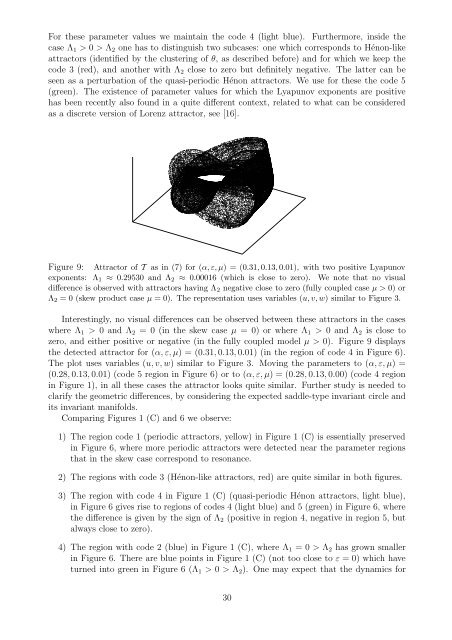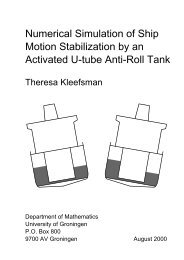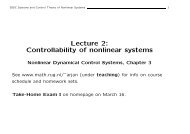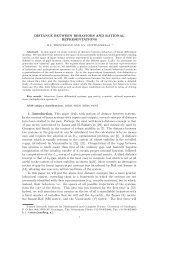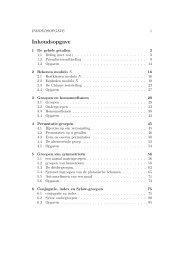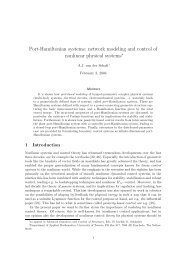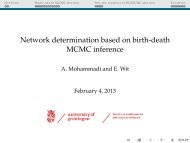Chaos and quasi-periodicity in diffeomorphisms of the solid torus
Chaos and quasi-periodicity in diffeomorphisms of the solid torus
Chaos and quasi-periodicity in diffeomorphisms of the solid torus
You also want an ePaper? Increase the reach of your titles
YUMPU automatically turns print PDFs into web optimized ePapers that Google loves.
For <strong>the</strong>se parameter values we ma<strong>in</strong>ta<strong>in</strong> <strong>the</strong> code 4 (light blue). Fur<strong>the</strong>rmore, <strong>in</strong>side <strong>the</strong><br />
case Λ 1 > 0 > Λ 2 one has to dist<strong>in</strong>guish two subcases: one which corresponds to Hénon-like<br />
attractors (identified by <strong>the</strong> cluster<strong>in</strong>g <strong>of</strong> θ, as described before) <strong>and</strong> for which we keep <strong>the</strong><br />
code 3 (red), <strong>and</strong> ano<strong>the</strong>r with Λ 2 close to zero but def<strong>in</strong>itely negative. The latter can be<br />
seen as a perturbation <strong>of</strong> <strong>the</strong> <strong>quasi</strong>-periodic Hénon attractors. We use for <strong>the</strong>se <strong>the</strong> code 5<br />
(green). The existence <strong>of</strong> parameter values for which <strong>the</strong> Lyapunov exponents are positive<br />
has been recently also found <strong>in</strong> a quite different context, related to what can be considered<br />
as a discrete version <strong>of</strong> Lorenz attractor, see [16].<br />
Figure 9: Attractor <strong>of</strong> T as <strong>in</strong> (7) for (α, ε, µ) = (0.31, 0.13, 0.01), with two positive Lyapunov<br />
exponents: Λ 1 ≈ 0.29530 <strong>and</strong> Λ 2 ≈ 0.00016 (which is close to zero). We note that no visual<br />
difference is observed with attractors hav<strong>in</strong>g Λ 2 negative close to zero (fully coupled case µ > 0) or<br />
Λ 2 = 0 (skew product case µ = 0). The representation uses variables (u, v, w) similar to Figure 3.<br />
Interest<strong>in</strong>gly, no visual differences can be observed between <strong>the</strong>se attractors <strong>in</strong> <strong>the</strong> cases<br />
where Λ 1 > 0 <strong>and</strong> Λ 2 = 0 (<strong>in</strong> <strong>the</strong> skew case µ = 0) or where Λ 1 > 0 <strong>and</strong> Λ 2 is close to<br />
zero, <strong>and</strong> ei<strong>the</strong>r positive or negative (<strong>in</strong> <strong>the</strong> fully coupled model µ > 0). Figure 9 displays<br />
<strong>the</strong> detected attractor for (α, ε, µ) = (0.31, 0.13, 0.01) (<strong>in</strong> <strong>the</strong> region <strong>of</strong> code 4 <strong>in</strong> Figure 6).<br />
The plot uses variables (u, v, w) similar to Figure 3. Mov<strong>in</strong>g <strong>the</strong> parameters to (α, ε, µ) =<br />
(0.28, 0.13, 0.01) (code 5 region <strong>in</strong> Figure 6) or to (α, ε, µ) = (0.28, 0.13, 0.00) (code 4 region<br />
<strong>in</strong> Figure 1), <strong>in</strong> all <strong>the</strong>se cases <strong>the</strong> attractor looks quite similar. Fur<strong>the</strong>r study is needed to<br />
clarify <strong>the</strong> geometric differences, by consider<strong>in</strong>g <strong>the</strong> expected saddle-type <strong>in</strong>variant circle <strong>and</strong><br />
its <strong>in</strong>variant manifolds.<br />
Compar<strong>in</strong>g Figures 1 (C) <strong>and</strong> 6 we observe:<br />
1) The region code 1 (periodic attractors, yellow) <strong>in</strong> Figure 1 (C) is essentially preserved<br />
<strong>in</strong> Figure 6, where more periodic attractors were detected near <strong>the</strong> parameter regions<br />
that <strong>in</strong> <strong>the</strong> skew case correspond to resonance.<br />
2) The regions with code 3 (Hénon-like attractors, red) are quite similar <strong>in</strong> both figures.<br />
3) The region with code 4 <strong>in</strong> Figure 1 (C) (<strong>quasi</strong>-periodic Hénon attractors, light blue),<br />
<strong>in</strong> Figure 6 gives rise to regions <strong>of</strong> codes 4 (light blue) <strong>and</strong> 5 (green) <strong>in</strong> Figure 6, where<br />
<strong>the</strong> difference is given by <strong>the</strong> sign <strong>of</strong> Λ 2 (positive <strong>in</strong> region 4, negative <strong>in</strong> region 5, but<br />
always close to zero).<br />
4) The region with code 2 (blue) <strong>in</strong> Figure 1 (C), where Λ 1 = 0 > Λ 2 has grown smaller<br />
<strong>in</strong> Figure 6. There are blue po<strong>in</strong>ts <strong>in</strong> Figure 1 (C) (not too close to ε = 0) which have<br />
turned <strong>in</strong>to green <strong>in</strong> Figure 6 (Λ 1 > 0 > Λ 2 ). One may expect that <strong>the</strong> dynamics for<br />
30


